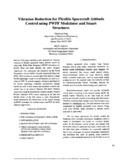Non-intrusive vibration monitoring in US Naval and US Coast Guard ships
| dc.contributor.advisor | Leeb, Steven B. | |
| dc.contributor.advisor | Hale, Patrick | |
| dc.contributor.advisor | Schantz, Chris | |
| dc.contributor.author | Gerhard, Katherine Leigh | |
| dc.date.accessioned | 2014-04-03T21:26:33Z | |
| dc.date.available | 2014-04-03T21:26:33Z | |
| dc.date.issued | 2013-06 | |
| dc.identifier.uri | https://hdl.handle.net/10945/40221 | |
| dc.description | CIVINS (Civilian Institutions) Thesis document | en_US |
| dc.description.abstract | In 2011, the Laboratory for Electromagnetic and Electronic Systems proposed a new type of vibration monitoring systems, entitled Vibration Assessment Monitoring Point with Integrated Recovery of Energy or VAMPIRE, in their work entitled "VAMPIRE: accessing a life-blood of informatin for maintenance and damamge assessment (1). The proposed monitoring system includes a self-power harvesting accelerometer installed in motors on US Navy and US Coast Guard vessels used to monitor equipment vibration and diagnose the source of the high vibrations. Utilizing the observations and tools designed by the VAMPIRE project as a foundation, this thesis takes the LEES lab-designed CAPTCHA accelerometers to the US Navy and US Coast Guard fleets to test the lab-designed tool, collect ship equipment data, and verify the VAMPIRE concepts. The CAPTCHA's ability to monitor the vibrations of these systems could be used to immediately diagnose system casualties, aid in parts repair, and ultimately, become a tool to promote Condition-Based Maintenance (CBM). Measurements and experimentation were conducted on two USCG ventilation fans in the lab as well as onboard the USCGC SENECA (WMEC-906), USCGC BERTHOLF (WMSL 750), USCGC STRATTON (WMSL 752), USS MICHAEL MURPHY (DDG 112), USS INDEPENDENCE (LCS 2) and USS sAN dIEGO (LPD 22). Data was collected and analyzed using a MATLAB program developed to diagnose the types of vibrations seen in various experiments and observe high vibrations in the commissioned ships. The combined results of the CAPTCHA-recorded lab tests and ship testing corroborate the theories proposed in the VAMPIRE paper; however, additional studies cuold make the VAMPIRE proposal a robust solution to a fleet-wide vibration-induced maintenance problem. | en_US |
| dc.description.uri | http://archive.org/details/nonintrusivevibr1094540221 | |
| dc.language.iso | en_US | |
| dc.publisher | Monterey California. Naval Postgraduate School | en_US |
| dc.rights | This publication is a work of the U.S. Government as defined in Title 17, United States Code, Section 101. Copyright protection is not available for this work in the United States. | en_US |
| dc.title | Non-intrusive vibration monitoring in US Naval and US Coast Guard ships | en_US |
| dc.type | Thesis | en_US |
| dc.contributor.corporate | Cambridge, Massachusetts : Massachusetts Institute of Technology (MIT) | |
| dc.contributor.department | Engineering and Management | |
| dc.description.service | US Navy (USN) author. | en_US |
| etd.thesisdegree.name | Naval Engineer | en_US |
| etd.thesisdegree.name | M.S. in Engineering and Management | en_US |
| etd.thesisdegree.level | Masters | en_US |
| etd.thesisdegree.discipline | Engineering and Management | en_US |
| etd.thesisdegree.grantor | Cambridge, Massachusetts : Massachusetts Institute of Technology (MIT) | en_US |
Files in this item
This item appears in the following Collection(s)
-
1. Thesis and Dissertation Collection, all items
Publicly releasable NPS Theses, Dissertations, MBA Professional Reports, Joint Applied Projects, Systems Engineering Project Reports and other NPS degree-earning written works. -
3. CIVINS (Civilian Institutions) Theses and Dissertations





